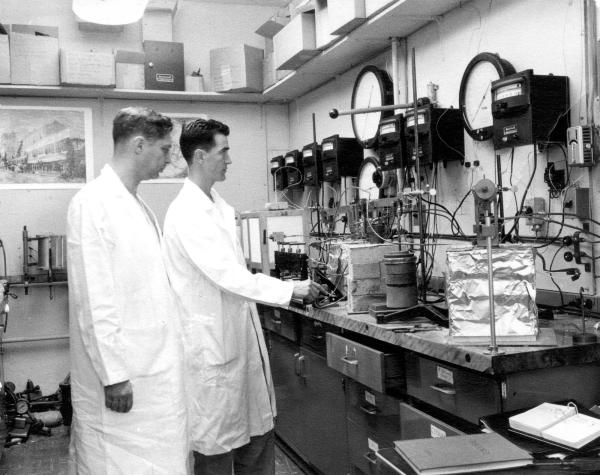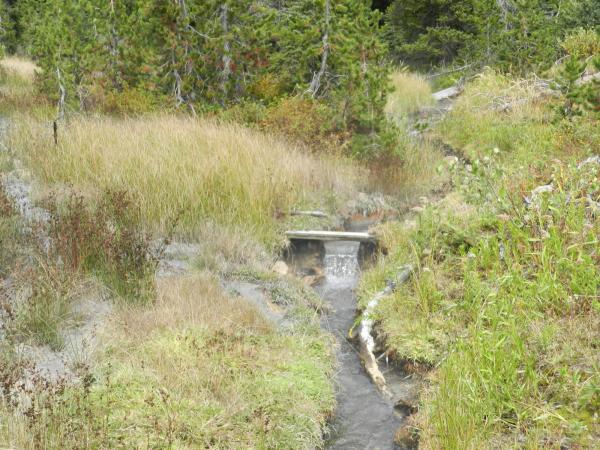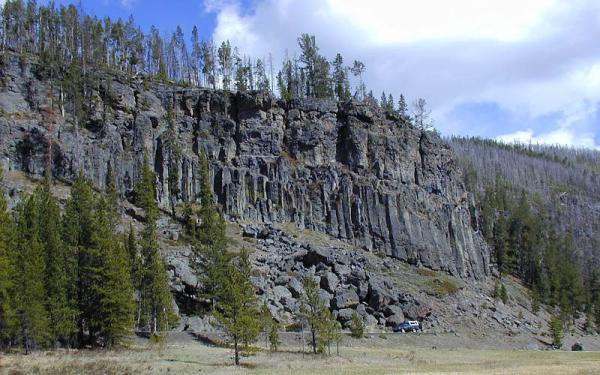Editor's note: Yellowstone Caldera Chronicles is a weekly column written by scientists and collaborators of the Yellowstone Volcano Observatory. This week's contribution is from Shaul Hurwitz, research hydrologist with the U.S. Geological Survey.
The water cycle (or hydrologic cycle) describes the movement of water between Earth’s main reservoirs: oceans (97 percent of the water), glaciers and ice sheets, lakes, rivers, soils, and the atmosphere. Water moves between the reservoirs by processes that include evaporation, precipitation, and river and groundwater flow. One of the most important ways scientists track the movement of water (H2O, a molecule with two hydrogen (H2) atoms and one oxygen (O) atom) from one reservoir to the other is by fingerprinting the different reservoirs with the stable isotopes of hydrogen and oxygen.
Isotopes are atoms of the same element that have the same number of protons but a different number of neutrons, meaning that their mass number varies. Stable isotopes have a nucleus that does not decay radioactively. Hydrogen has three naturally occurring isotopes, 1H (which accounts for more than 99.9% of natural hydrogen), 2H (also called deuterium), and 3H (called tritium and which decays radioactively). Oxygen also has three naturally occurring isotopes, 16O, 17O, and 18O. Characterizing the isotopic fingerprints of water and the processes that lead to variations in isotope ratios (for example, the ratio of 2H to 1H) is commonly applied to address a wide range of scientific problems, such as detecting different sources of water and reconstruction of past climates.

Irving Friedman (left) and William D. Long in 1958 carrying out experiments with welded volcanic tuffs at a USGS laboratory in Washington, D.C. Results from these experiments were presented in a journal publication on the hydration of natural glass and formation of perlite (a volcanic glass with a concentric structure). Photo by E. F. Patterson (https://library.usgs.gov/photo/index.html#/item/51dda09ee4b0f72b4471ddad).
Understanding how stable isotopes are used for tracking water is the story of USGS scientist Irving Friedman (1920–2005), a scientist considered by many to be the “father of isotope hydrology” because of his numerous innovative breakthroughs. Irving grew up in New York City and headed west to get a B.S. degree from Montana State University and a M.S. degree from Washington State University, both in chemistry. During World War II, he was assigned to the Naval Electronics Laboratory, where he used laboratory experiments to study hydrothermal growth of quartz. The results of his research helped with the development of the synthetic quartz industry. Friedman completed his Ph.D. at the University of Chicago in 1950, where he conducted high-temperature laboratory experiments including testing models for the origin of granite.
Friedman then joined a celebrated group of scientists in Nobel laureate Harold Urey’s laboratory at the Institute for Nuclear Studies in Chicago. There, he built the first mass spectrometer for routine measurement of hydrogen isotope compositions based on plans he received from physicist Alfred Nier (the pioneer of mass spectrometry development). Irving then made the first measurements of hydrogen isotopes in ocean water, and in 1953 he published a landmark paper "Deuterium content of natural waters and other substances."
In 1952, Friedman began a 43 year-long career at the USGS, during which he investigated every aspect of the water cycle by applying stable isotopes to study oceans, rivers, lakes, glaciers, hot springs, and the atmosphere, and he had a career-long interest in scientific studies at Yellowstone National Park. He applied stable isotope chemistry to characterize travertine formation at Mammoth Hot Springs, and with USGS colleague Dan Norton he established a network of gages in Yellowstone’s major rivers, as well as in the remote southwest corner of the park and at Norris Geyser Basin, to measure chloride flux, which is a way to track the amount of heat emanating from the Yellowstone magmatic system. Their work has paved the way for the current monitoring network that provides real-time information on hydrothermal flow from thermal areas.

A weir constructed by Irving Friedman and Dan Norton to measure water discharge and to monitor changes in hydrothermal activity on a tributary flowing into Boundary Creek in southwest Yellowstone National Park. USGS photo by Shaul Hurwitz, September 17, 2017.
Friedman also made many seminal contributions to other research fields. In 1960, he developed (with USGS colleague Robert L. Smith) the obsidian hydration dating method, which allowed for significant advances in archaeology and anthropology and to correlate the glaciations in the Yellowstone Plateau. He was one of the first to demonstrate how the exchange of oxygen isotopes between magma and groundwater can affect the formation of rhyolite, and he characterized the chemical composition and magnetic properties of tektites (glassy objects that have been melted by meteorite impact). He was also one of the first to determine the isotopic composition of Moon rocks collected by Apollo 14 and 15.

Obsidian Cliff off the Grand Loop Road between Mammoth Hot Springs and Norris Geyser Basin. The vertical columns are cooling fractures that formed as the thick rhyolite lava flow cooled and crystallized. The flow consists of obsidian which forms when magma rich in silica has cooled without forming crystals, creating a dark volcanic glass that can have a very sharp edge. Irving Friedman was a pioneer in using obsidian for applications in geology, archeology, and anthropology. USGS Photo by Steve Brantley, 2001.
In addition to being a pioneering scientist, Friedman was an adventure enthusiast. With his wife Rita, he flew his own plane to remote sections of Mexico and Alaska and routinely to Gardiner, Montana, from where he took off for numerous trips into remote areas of Yellowstone National Park. With Rita and friends, he enjoyed skiing, hiking, scuba diving, and sailing the lakes of Colorado and in the oceans.
For his outstanding career achievements, Friedman received several awards and honors, including the Department of Interior Meritorious Service Award, the Congressional Antarctic Medal, Honorary Fellowship in the Geochemical Society, and he was made an Honorary Yellowstone Park ranger for his longtime scientific contributions leading to better protection of the park and its resources.




 Support Essential Coverage of Essential Places
Support Essential Coverage of Essential Places






